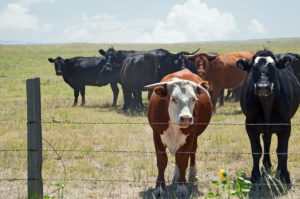By Kent Tjardes
If you’re a kid at the swimming pool, the heat of summer can be delightful. But for cattle, summer heat can be dangerous, even deadly. “Heat stress in cattle is not something to be taken lightly,” says Kent Tjardes, Ph.D. and cattle consultant with Purina Animal Nutrition. “A few precautionary steps are essential to help cattle through hot weather.”
Be Water Wise
The Most important essential is the availability of clean, fresh water for all cattle. “Cattle water intake can increase by up to 50 percent during extreme heat,” says Tjardes. “Water not only prevents dehydration, but many animals will place their tongue and nose in the water to help cool the body.” Here are some water Tips:
- Consider adding trough space when cattle are crowding existing water sources. The recommended standard linear waterer space is about .75 inches per head. But increasing linear area to two or more inches per head has been show to decrease heat stress.
- Monitor Calves carefully for water intake. Calves are small, and they get dehydrated quickly. Cows typically drink first, making calves second in line. Make sure there is enough water flow for the calves after the cows have been at the water source. After a few long hours in the heat, the last thing you want is calves to return to an empty waterer.
- Ensure water sources are at an appropriate height for calves to access. The height of some waterers makes it hard for calves to access, discouraging water intake.
Control Flies
Controlling flies is another essential strategy.”Biting, irritation, and blood loss caused by flies adds stress to the animal,” says Tjardes. “To protect themselves from flies, cattle often group together. But this behavior can cause animals at the center of the group to become overheated.” Use fly control methods to reduce irritation, grouping behavior, and help alleviate heat stress caused by grouping. Here are some go-to fly control methods:
- For pasture settings, offer Purina Wind and Rain Storm Fly Control Mineral with Altosid Insect Growth Regulator (IGR) to target horn flies.
- In feedyard settings, consider a custom Purina supplement with ClariFly to control house, stable, face, and horn flies.
- In any environment, cleanliness is critical. Scrape manure out of lots, remove excess feed along the outside of bunks and cut weeds to help reduce fly populations.
More Essentials
In addition to water management and fly control, here are a few more essential to help cattle beat the heat.
- Offer shade: shade can’t always be provided but, when available, it can help cattle avoid heat stress.
- Consider air flow: A five to ten mph wind helps to cool the animal’s body temperature. Avoid the use of pens with limited air flow (i.e., pens surrounded by tall cornfields or bales) or remove potential windbreaks. If you do use pens with limited airflow, build mounds within them to help raise cattle to an elevation of airflow.
- Don’t handle the cattle in the heat: If possible, consider waiting until a cooler day. If you must work animals, do so in the morning when the temperature tends to be the lowest.
A few small changes can help keep cattle comfortable when the summer temperature rises.
Source: Purina Poultry





